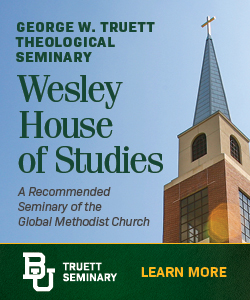By Steve Seamands
In the American church and in our culture in general, we are so accustomed to seeing crosses on church buildings or in sanctuaries, wearing them on chains, or carrying them in processions that it’s virtually impossible for us to grasp the utter horror that the very mention of crucifixion provoked in the Ancient World. “Do you sell gold crosses?” a customer inquired in the jewelry section of a Denver, Colorado, department store. “What kind would you like?” asked the clerk, as she pulled out one of the trays, “A plain one or one that has the little man on it?” For most of us, the cross is an endearing, often sentimental, religious symbol that evokes positive feelings.
Originally, however, when the apostles preached about the cross it was the absolute antithesis of that. Far from being a religious symbol, originally the cross was shocking, revolting and offensive, a disgusting irreligious symbol if there ever was one. Since the typical Methodist today is largely unaware of this, it is important to recover, what the apostle Paul calls, the “scandal” of the cross (1 Corinthians 1:23). What has become so familiar to us needs to become strange again. As Fleming Rutledge puts it:
“Not even the celebrated film by Mel Gibson, The Passion of the Christ, can convey the full ghastliness of crucifixion to a modern audience. We don’t understand it because we have never seen anything like it in the flesh. The situation was very different in New Testament times….Everyone knew what it looked like, smelled like sounded like—the horrific sight of completely naked men in agony, the smell and sight of their bodily functions taking place in full view of all, the sounds of their groans and labored breathing going on for hours and, in some cases, for days. Perhaps worst of all is the fact that no one cared.”
We tend to associate the horror of crucifixion with agonizing physical pain—what Mel Gibson so vividly portrayed in his film. And it’s no accident that our English word, excruciating, is derived from crux, the Latin word for cross. The International Standard Bible Encyclopedia describes it like this:
The wounds swelled about the rough nails, and the torn and lacerated tendons and nerves caused excruciating agony. The arteries of the head and stomach were surcharged with blood and a terrific throbbing headache ensued. . . . The victim of crucifixion literally died a thousand deaths. . . The suffering was so frightful that ‘even among the raging passions of war pity was sometimes excited.’”
Yet despite such unbearable physical agony, people in Roman times dreaded the shame associated with crucifixion even more. Since crucifixion was reserved for the dregs of society, outcasts, slaves and common criminals, the fact that one was crucified defined him as a miserable, wretched being that didn’t deserve to exist. By pinning them up like insects, crucifixion was deliberately intended to display and humiliate its victims. It was always carried out in public, often at a prominent place such as a crossroads, outdoor theater or hill. Crucifixion was a spectacle event, a grisly form of entertainment where men and women jeered and heaped ridicule upon the victim. The public mockery of Jesus during his crucifixion (Mark 15:29-32) was typical. The fact that those crucified were completely naked added to the shame. So did the fact that they were often denied burial and became food for vultures and other scavengers.
Crucifixion, then, was deliberately designed to be loathsome, vulgar, revolting and obscene. That’s why, although common in Roman times, it was rarely mentioned in cultured literary or social settings. Crux was a four-letter word, not to be used in polite company. Cicero, one of Rome’s greatest philosophers, said that no respectable person should ever have to hear it spoken.
The hideous shame associated with crucifixion was the main reason why the message of the cross seemed ludicrous to its original hearers. As Paul put it, “When we preach that Christ was crucified, the Jews are offended, and the Gentiles say it’s all nonsense” (I Corinthians 1:23). To proclaim that someone hanged on “the tree of shame” was the Savior of the world or the Messiah was bizarre, disgusting–sheer madness.
Alister MacGrath likens the early Christian preaching of the cross to a modern business or corporation choosing a hangman’s noose, lynching tree, firing squad, gas chamber or electric chair as its logo. What advertising agency would advise you to choose an instrument of execution as the symbol of your organization? “Its members would instantly be regarded as perverted, sick, having a morbid obsession with death, or having a nauseating interest in human suffering….Only an organization determined to fail as quickly and spectacularly as possible would be mad enough to choose such a symbol.”
But that’s exactly what the early Christians did. They made it the centerpiece of their preaching. As Paul reminded the Corinthians, “When I first came to you I didn’t use lofty words and brilliant ideas to tell you God’s message. For I decided to concentrate only on Jesus Christ and his death on the cross” (I Corinthians 2: 1-2). As strange and outlandish as it seemed, they were convinced it was the supreme demonstration of the power and wisdom of God.
The scandal of the cross helps us understand how God works to accomplish his redemptive purposes in the world. As God declares through the prophet, Isaiah, “My thoughts are completely different from yours…And my ways are far beyond anything you could imagine” (Isaiah 55:8).
The cross reveals that God’s upside down kingdom is often downright offensive to us. God uses that which the world considers despicable and weak to manifest his power. What does that say about our desiring strength as the world counts strength? Or our attempts to downplay or soften the offense of the cross?
The scandal of the cross also reveals who God takes sides with. By allowing himself to be “counted among those who were sinners” (Isaiah 53:12), crucified between two despicable criminals, God casts his lot with the poor, the powerless, the wretched, the dispossessed of the earth. Liberation theologians speak of God’s “preferential option for the poor.” What is seen throughout scripture–God’s concern for the helpless, the outcast, the widow, the orphan, the fatherless and the oppressed–is impossible to miss when the Son of God hangs on a cross between two thieves.
And of course, all this has profound implications for us and our churches. As the writer of Hebrews tells us, if he suffered “outside the city gates,” in the garbage heap, the place of disgrace, among the reviled, “so let us go out to him outside the camp and bear the disgrace he bore” (Hebrews 13:13). We too are called to be involved with the lowest and the least, the despised and the dispossessed of the earth.
John Wesley came to understand this in a profound way when, about ten months after his heartwarming experience at Aldersgate, he embarrassingly descended into field preaching on April 2, 1739. Here’s how he describes the event in his journal: “At four in the afternoon I submitted to be more vile and proclaimed in the highways the glad tidings of salvation speaking from a little eminence in the ground adjoining to the city to about three thousand people.”
Until then, Wesley had been a strict Oxford don who was concerned that things be done “decently and in order.: That meant preaching should happen in a pulpit in church buildings. Finicky about his personal appearance, he couldn’t tolerate a speck of dirt on his clothing. He hated commotion and disturbance, preferring the quiet of a university library to the noise of a large crowd. In the light of his personal preferences, no doubt field preaching for Wesley was “submitting to be more vile.” Although he would continue to engage in it throughout his life, he never became fully comfortable with it. As late as 1772 he admitted, “To this day field preaching is a cross to me.”
It was a cross to Wesley, because in “submitting to be more vile” he had, in effect, recovered and was participating in the scandal of Christ’s. What would happen if we Methodists today, following in Wesley’s footsteps, “submitted to be more vile”—regardless of what it means in our day and time? What would happen if, in following in the footsteps of our Lord Jesus, we would recover, both in our understanding and practice, the scandal of his cruel, ugly cross?
Stephen Seamands is Professor of Christian Doctrine at Asbury Theological Seminary, Wilmore, Ky. This article is adapted from a chapter in his forthcoming book to be published by InterVarsity Press.






0 Comments